It may not be one of Japan’s most visited cities but Nagoya boasts one of the country’s prettiest castles. We were in Nagoya for a couple of days on our way to Guam. Nagoya was never on my cities to visit before but it was a convenient stopover in our complicated summer itinerary. I’m glad we got to visit Japan’s fourth largest city briefly and Nagoya Castle (Nagoya-jo) with its rich history was a memorable attraction.
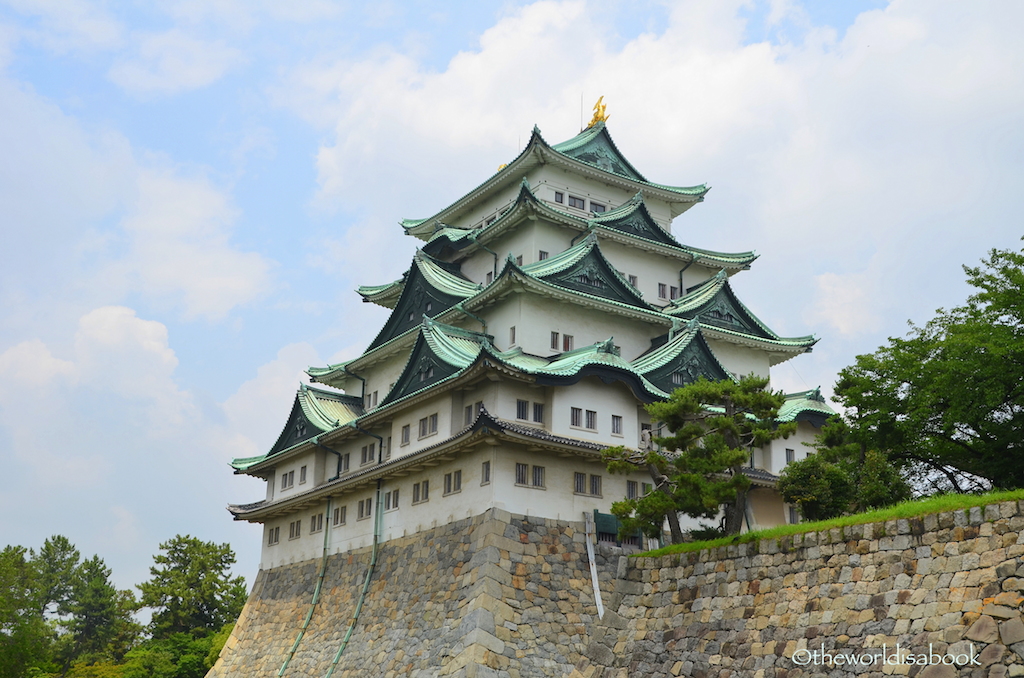
Getting to the Castle
In order to get to the castle, one must pass through expansive grounds and gardens. Ninomaru Garden beautifully represented a meticulously arranged and maintained Japanese landscape garden.
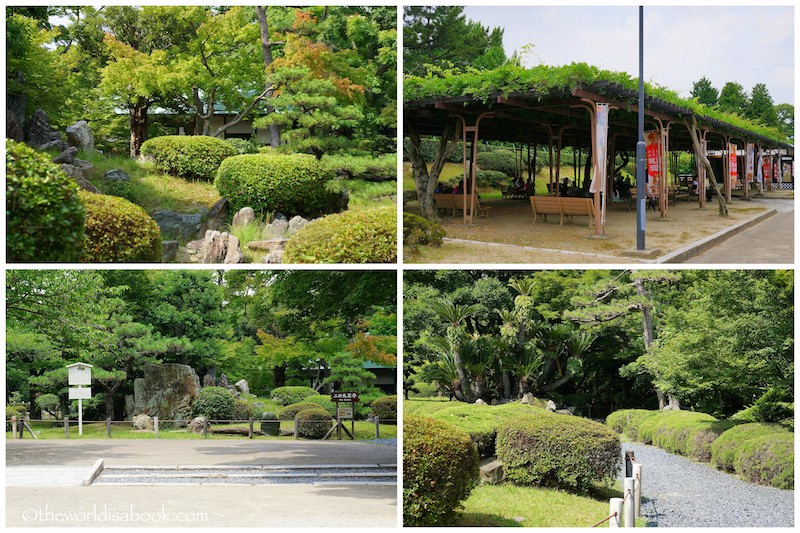
This was the Southeast Corner tower that sat on a stone wall. There were two others nearby (southwest and northwest).
People considered these as the castle’s important cultural assets. It stood three stories tall with a two-level roof near the east entrance we used.
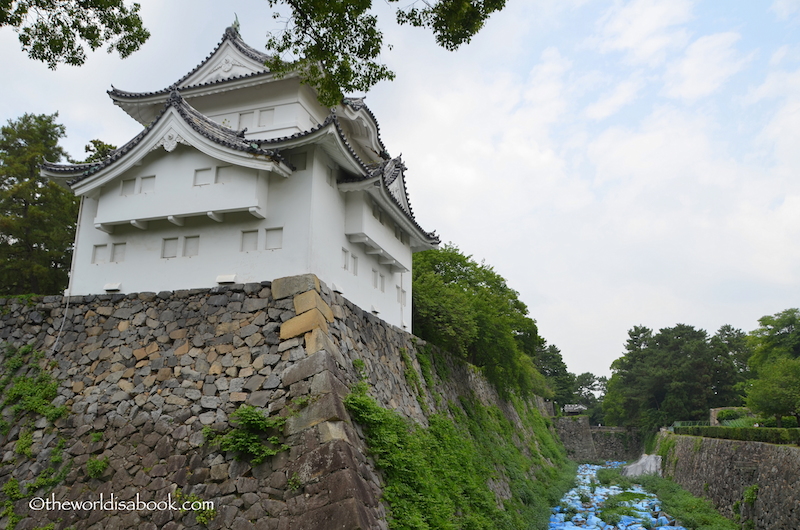
As we rounded the corner, we caught sight of a magnificent structure that looked like it was part of a fairytale scene. Perched on a stone wall was Nagoya Castle and looked very much like the how I would have envisioned an ancient castle in imperial Japan.
Nagoya Castle History
The Owari lineage of the ruling Tokugawa family completed Nagoya Castle in 1612. They used it as a residence and burnt down during the World War II air raids in 1945. Some of the structures that avoided destruction were the corner towers.

Although reconstructed in 1959, this current castle or donjon still impresses. It was about 64 feet (19.5 m) tall from the moat to the stone wall foundation.
The 5-story structure was 110 feet (33.5 m) tall. It is now a modern museum with various interesting exhibits on the castle’s history.
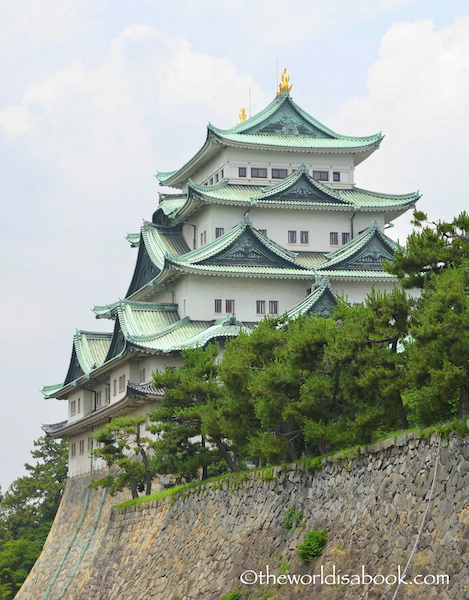
Rebuilding the Castle
We passed by a scaffolding structure and learned this was a major project to rebuild the castle’s Honmaru Goten Palace with traditional construction materials and techniques and based on original designs. Visitors can go inside the construction area and watch the reconstruction project every day except Tuesday and Thursday. Unfortunately, we were here on a Thursday which was disappointing.
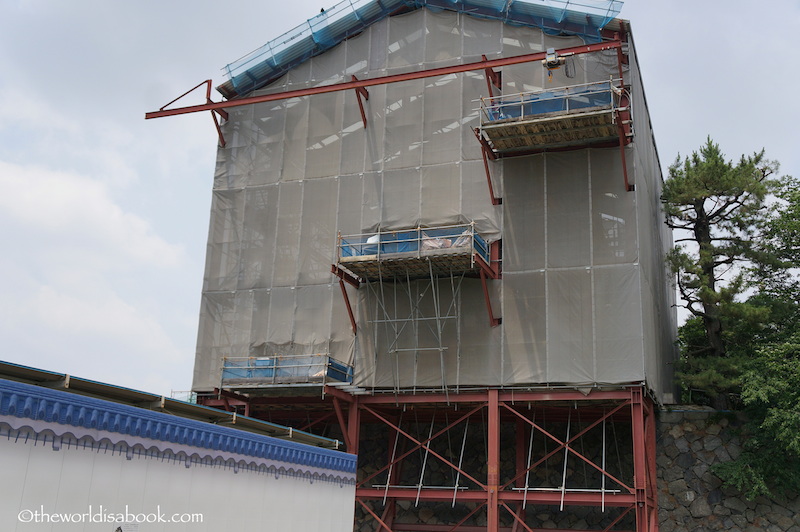
Castle Grounds
The back of the castle showed some tea houses. Visitors could enter for some tea and sweet treats. There were some other small structures and signs around the grounds but we didn’t really know what they were since there were no signs.
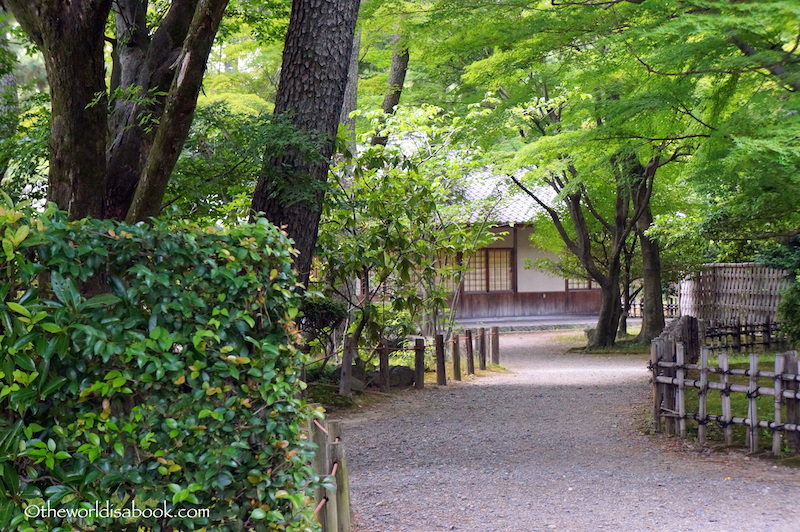
It was hard not to miss the two golden sea creatures on Nagoya Castle’s rooftops representing a male and female. They called them Kinshachi-jo, where Kin means “gold,” and shachi were mythical creatures. People believed the shachis could summon water and prevent fires.
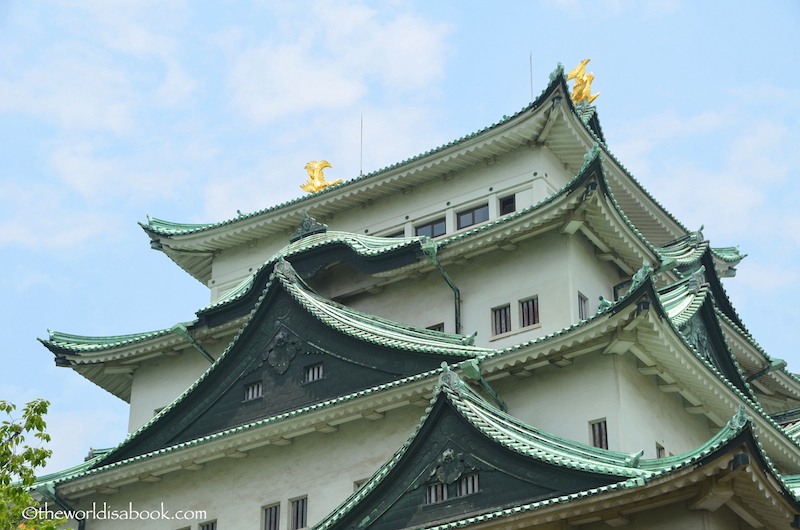
They were initially placed on top to show the Tokugawa family’s wealth and power. These were also added during the reconstruction in 1959 and each weighed about 43 kg of gold. They have become part of the city’s symbol.
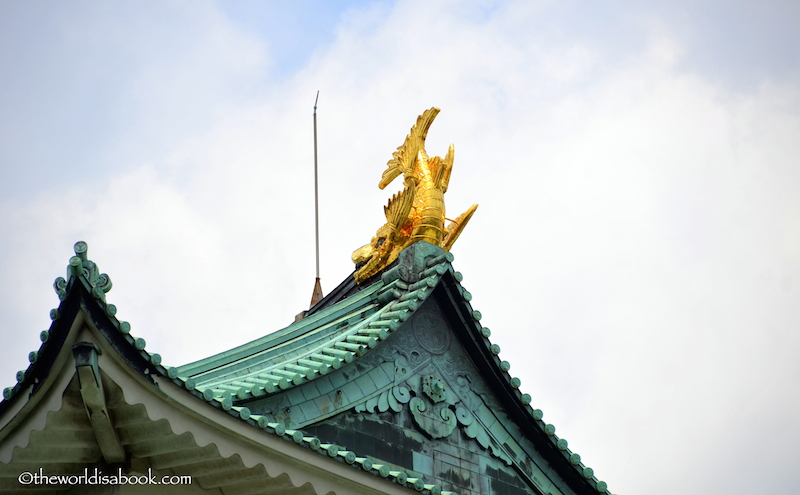
One of the unique features of the castle was its sloping walls. Since the castle was on a flat land, wide moats and sloping walls were part of its defense mechanisms.
They used a technique called fan sloping (ogi kobai) to create the walls. The wall’s middle area was curved inward for balancing those large stones while the upper portion was curved outward in a fan shape.
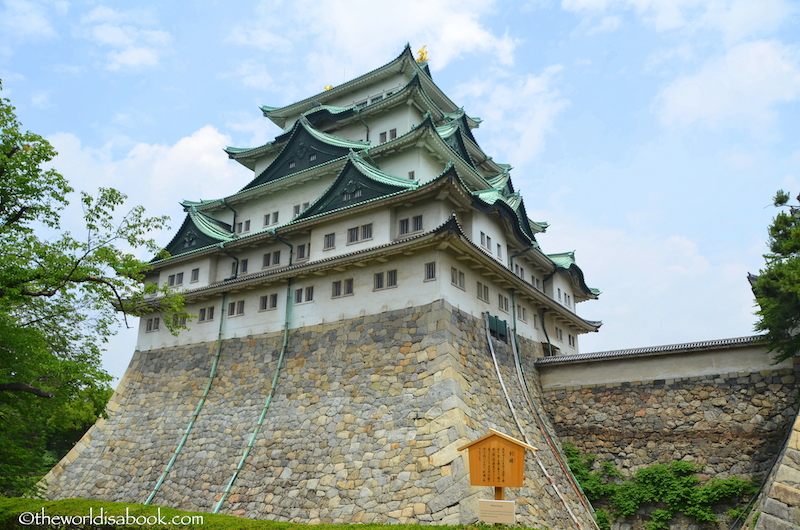
We found Ofukemaru near the walls behind the castle. These stones originally formed part of the original castle tower’s foundation and eventually moved here during the reconstruction in 1959.
My kids, on the other hand, thought it provided a good foundation for hopscotch. It was one of the few shaded areas in the complex.
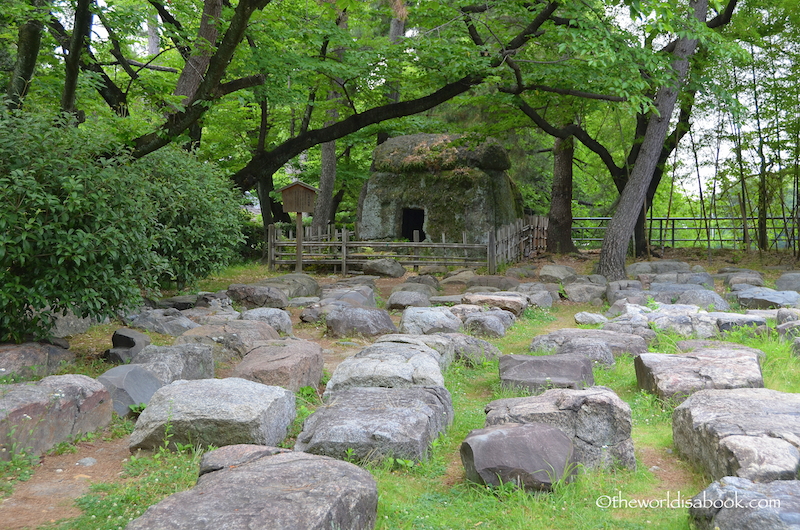
From this area, we got a good view of one of the wide moats that surrounded the castle.
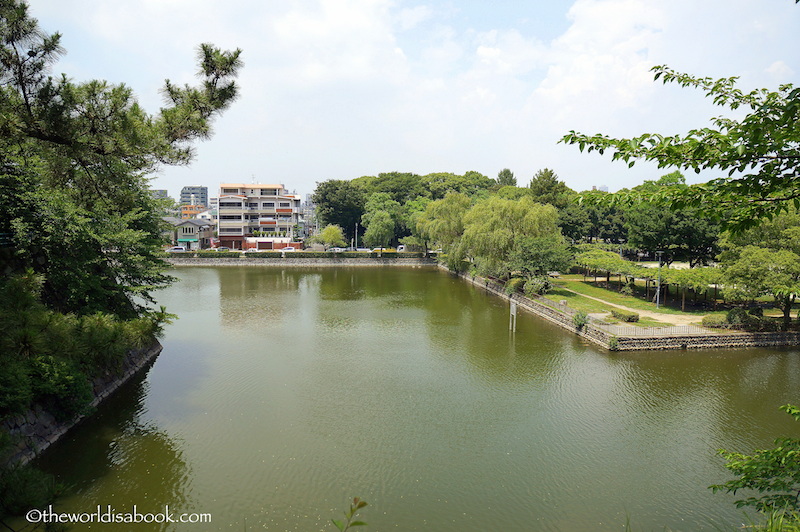
This modern staircase, attached to the structure, was towards the entrance of the museum and at the back of the castle. We thought this could have been built for emergency escapes.
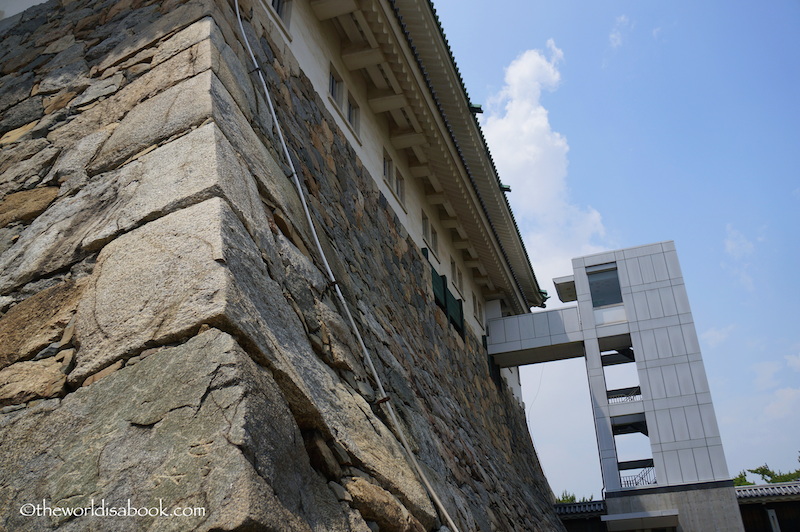
The Castle Interior
We entered the castle through this roofless passageway that gave a majestic view of the building and a closer look at the roof details.
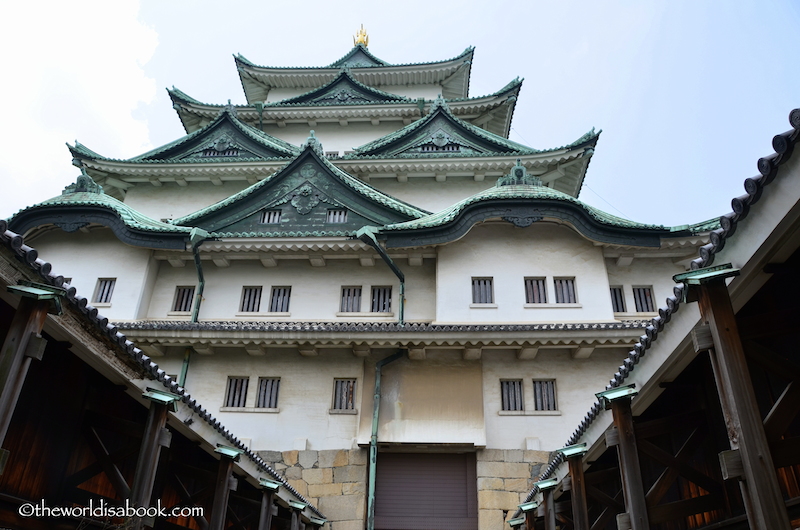
It’s sometimes hard to engage kids inside historical museums especially in foreign countries. This was five floors plus a basement full of treasures and information.
Nagoya Castle’s museum did a wonderful job in keeping my kids and the myriad of other kids here on field trips occupied. There were armors, weapons and samurai related exhibits sure to fascinate many little boys and some men. My husband found it way more interesting than my son.
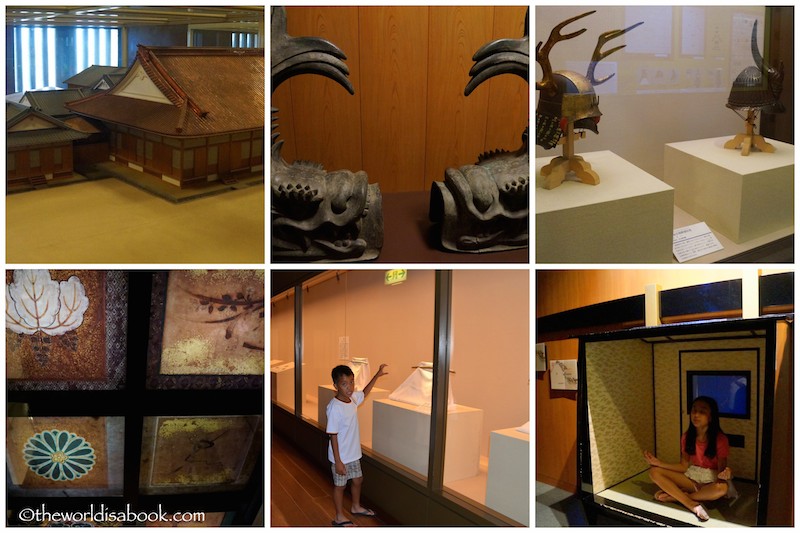
We found replicas of the Kinshachi-jo inside the museum too. It was great to see how it actually looked up close.
I think it looked more like a giant fish instead of a dolphin. What does it look like to you? There was even a full-size version of the Golden Dolphin for kids to climb, sit and pose with.
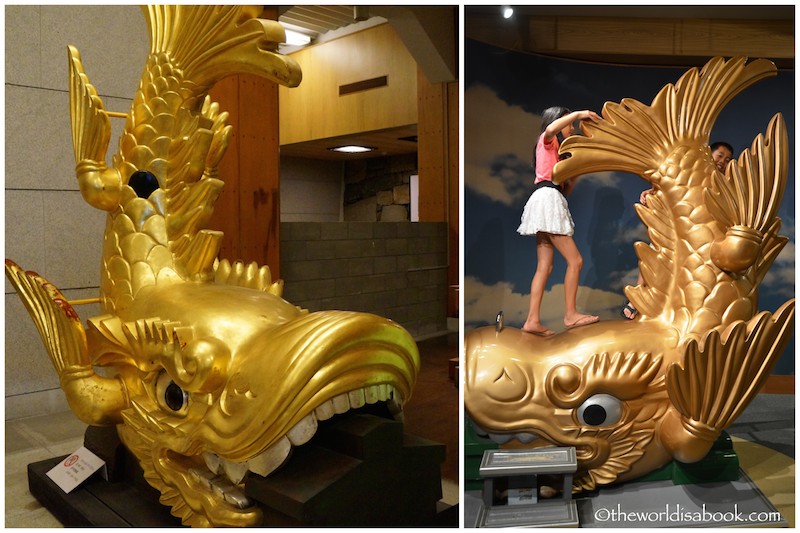
The Castle Town
We really liked the area that showed how the castle town and streets looked in the Edo period. It included some recreated shops and scenes of how the castle lord and the town people lived.
It almost felt like we traveled back in time. We saw tatami-floored rooms. These rooms welcomed guests and a dining area for the castle lord. It included displays of some of the meals he enjoyed. I found the kitchen room and the Honya bookstore very interesting.
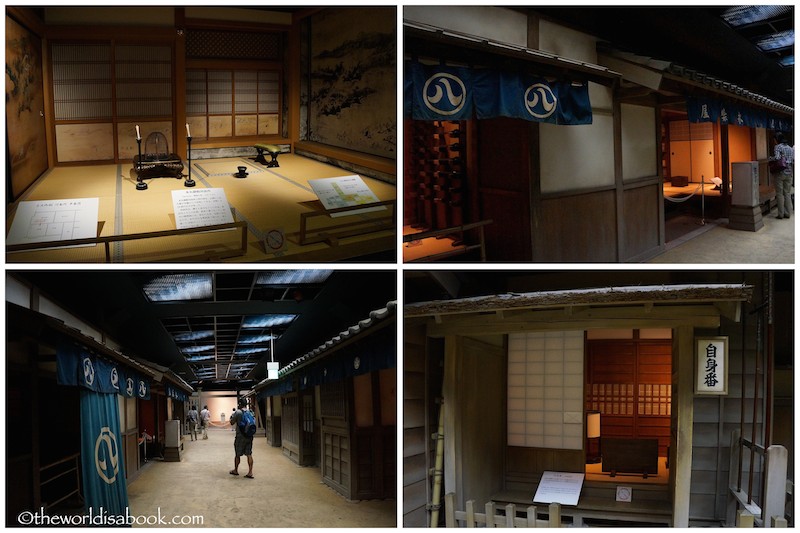
Many of the exhibits were well laid out. There were enough English signs that gave us an idea of the display and history of the pieces.
Some of the art, paintings, and unique fusuma-e (sliding door paintings) that survived the bombings were on display. Many more are undergoing restoration and will be exhibited when the Hommaru Palace opens. It’s amazing to see how some of these survived considering the devastation this complex suffered.
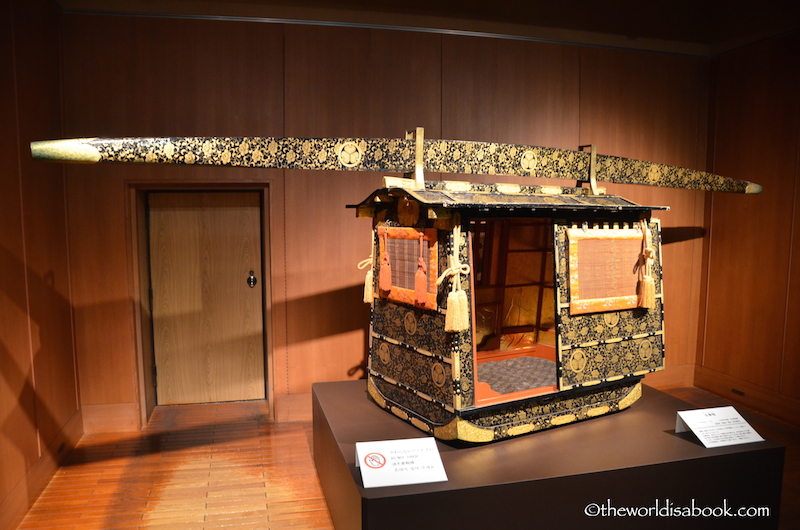
Moving Stones
Many of the kids found this model of how the construction workers transported and moved stones that created the castle’s stone walls very informative and interesting. Visitors could also try their hand at pulling ropes tied to stones. It gives insight into to the movement of stones.
A couple of the methods used were by using a rolling log path to haul stones or by pulling wooden sleds. It gave everyone an insight into what these workers endured and made us appreciate this castle’s construction even more.
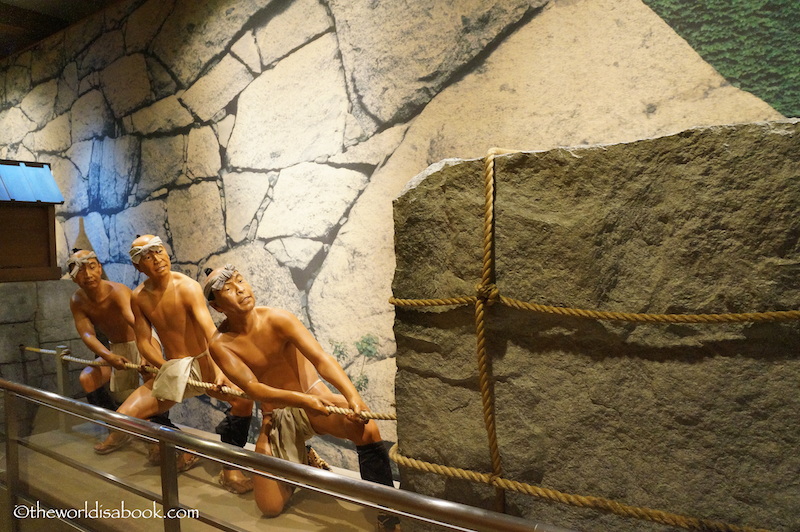
Castle Views
One of the best parts with climbing to the top of the castle and the observation deck were the panoramic views of downtown Nagoya. It was a bit hazy during the summer day but I’m sure one could see for miles on a clear, winter day. There was also a small shop here for some unique souvenirs and Japanese goodies.
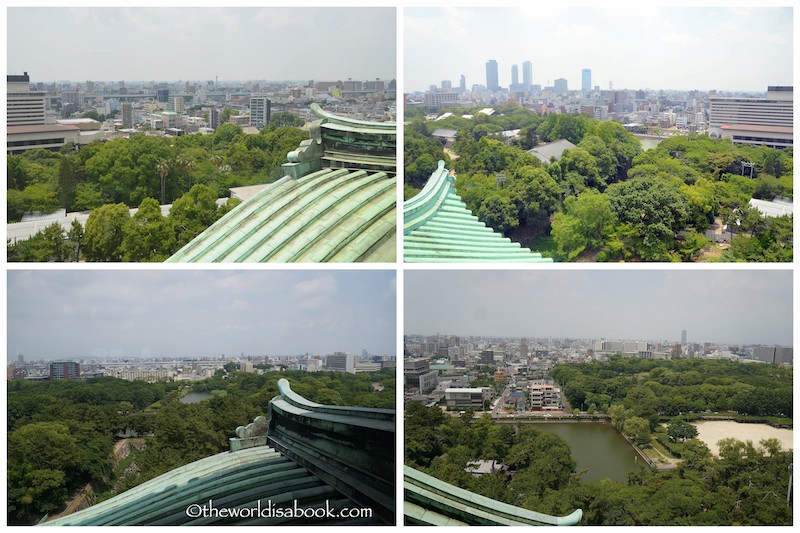
The Castle Grounds
There were other things that made this visit memorable which included people watching and seeing some unique characters on the castle grounds. I always love seeing brides all over the world dressed in their traditional attire.
We found this wedding party on a photo shoot. This was the closest we got to her without being obtrusive. It was hot and humid so it was so admirable to see them still smiling while wearing many layers of clothing.
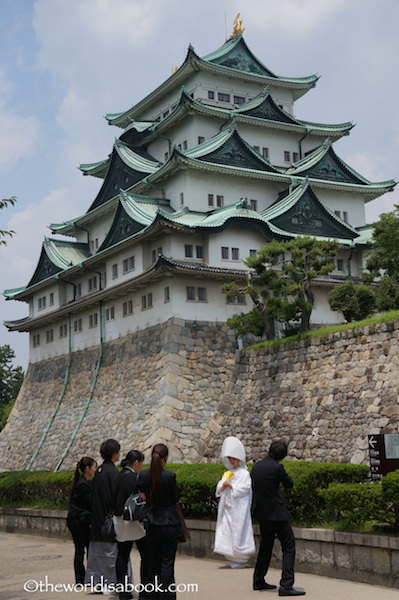
In keeping with the castle’s golden dolphins mascot, we found these guys walking around and posing with visitors.
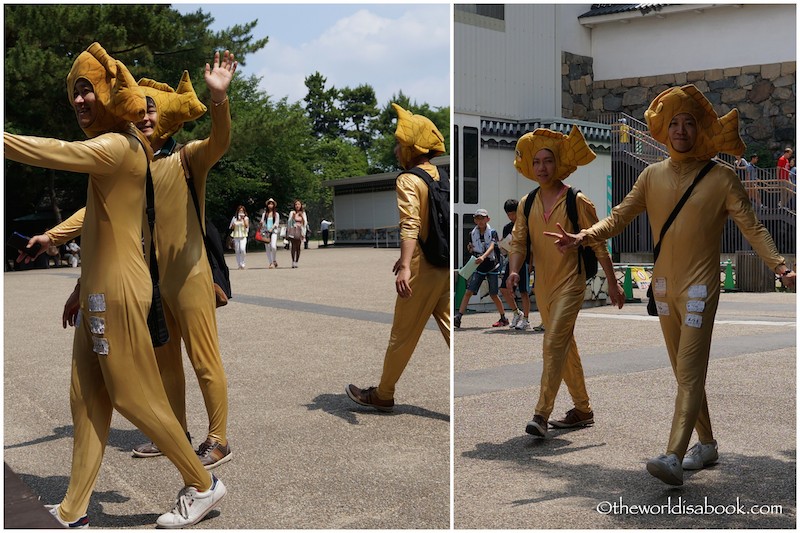
We also found these young ladies dressed in kimonos singing their hearts out near the exit. We didn’t understand all of what they were saying but their little show was very entertaining.
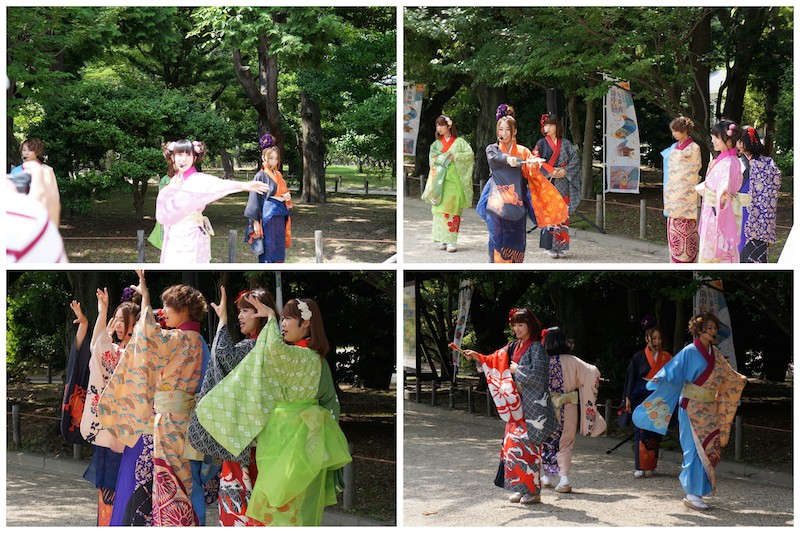
So, how long to visit Nagoya Castle? It only took us about three hours to visit and cover most of Nagoya Castle’s grounds and museum.
It may be a reconstuction but it gave us an insight into this city’s unique history. We would love to return someday and see the completed palace and display of the castle’s treasures.
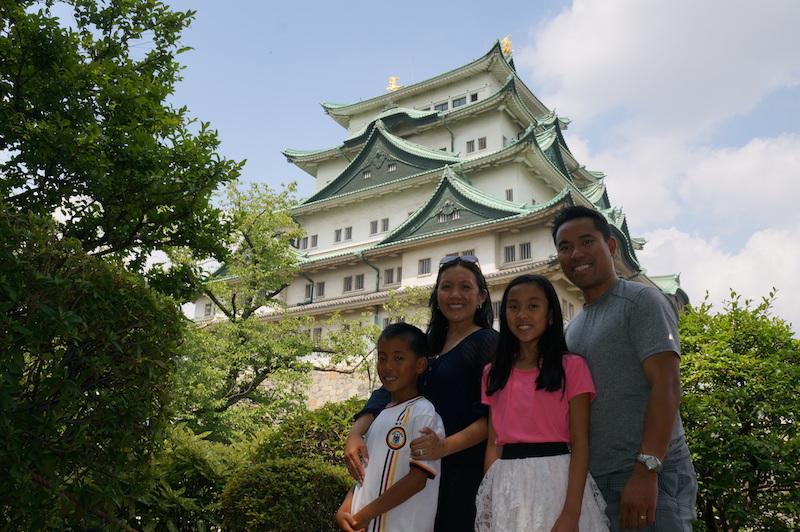
Tips for Visiting Nagoya Castle
- Getting There: These are various subway stops to get there depending on your location.
- Get off at the “Shiyakusho (City Hall)” or M07 stop of the Meijo Line.
- Get off at the “Sengencho” or T05 stop of the Tsurumai Line.
- Prices: Adults 500 yen; Kids 13 and under are free
- Snacks including shaved ice and ice cream were for sale near the museum entrance. Seating under shade available.
- Come here on days other than Tuesday or Thursday to see the Hommaru palace restoration project.
- No food/drinks were allowed inside the castle
Have you visited Nagoya Castle or other Japanese castles?
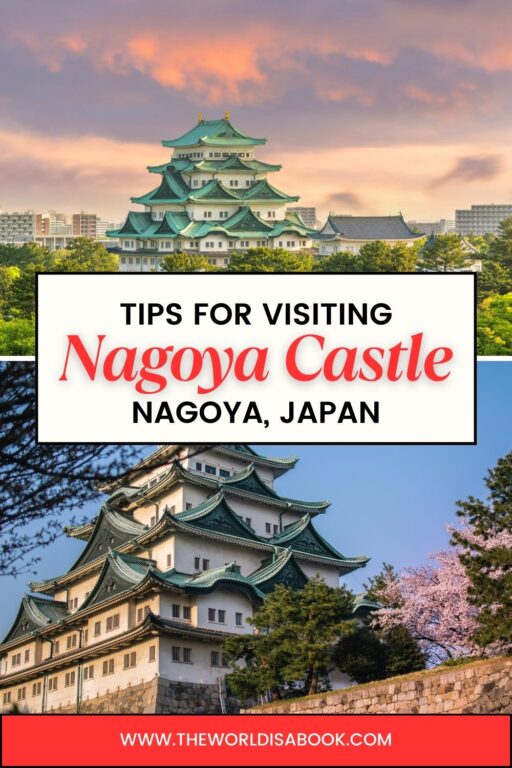
The castle looks like a wedding cake perched on the edge of a table. It must have been fun to explore.
It was very fun to explore. I never would have thought of the castle that way. Thanks for the visual!
Looks like an amazing place to visit. I love the architecture.
It was an amazing place to see in person. The architecture is even better in person. Thanks Brittany!
Great photos, we’ve not made it to Nagoya castle yet but have done a few of the others. Looks like it should be on our list for a future trip.
Thanks Toni! I hope you make it to this castle soon. I’d love to return and explore the other Japanese castles.
It’s not Bangkok, but it still looks interesting. I like that they are doing the reconstructions with original material and techniques. Although, are they using cranes instead of having many people pulling with a rope, I wonder. That Edo era museum seems like it would give a good context to the times when the original castle was first built. And I really like the helmet with the antlers.
No, it’s a bit different from Bangkok but it was worth a visit. I’m not sure what machineries they’re using but we didn’t see any cranes. We’d love to go back and visit the museum and palace.
I love the construction and swing of the eaves. Architects and builders must have had a ball making that castle.
I’m sure they did, Mette. I can’t imagine how much work it took to recreate this castle.
Castles – no matter what the country – do seem magical, don’t they? And they certainly spark the imagination. Great photos and most informative narrative!
I love this castle! It’s beautiful! I’m also glad they have some English signs on the inside, that makes it easier for us to learn about the history. I’d love to explore this place.
Lovely pictures…
Thanks Lili!
Love the intricacies of Japanese castles; so different from the ones we have in Europe.
Doesn’t look at all like a traditional castle – but what a beauty.
The castle is so beautiful! I would love to visit Japan one day :)
OMG!That looks stunning! I didnt even knew about! Thanks for sharing, I will put it on my list of spots I will visist!! Its amazing to see how hard it was to build p the castle. Today we have all these machines and they had to to all of it with their hands..really crazy :)
Greetings from a German traveller :)
Oooo, I’m a big fan of castles so this one is definitely going on my list! Now I just need to get myself to Japan…
Thanks for sharing, Mary!
Happy travels :)
Such a beautiful building – and so much interesting history to learn about! Love the views over downtown Nagoya – such a juxtaposition of the modern city and the historic castle!
Beautiful castle and beautiful grounds. I guess a castle can’t go without a pretty garden. I love castles and I hope to get to visit Nagoya someday, but for not I didn’t even set foot in Asia, so I don’t even know where to begin.
I didn’t entertain the thought that Kinshachi-jo was anything but a fish – good to know it was a dolphin – that makes sense. It was interesting to see the difference between European Palaces and Japanese. The wide moat reminded me of Angkor Wat. What a great idea having a rock pulling display there – very thought provoking.
I love the shape of the building and the curved walls. It may be a defense mechanism, but it definitely gives the castle some character.
This is one of my must see places if and when we get the chance to go to Japan. How far away is this from Tokyo if we take a bullet train?
According to some searches, it’s supposed to be 100 minutes from Tokyo on the bullet train. I hope you get to visit Japan soon.
That castle is amazing. Suddenly, I want a Japanese castle.